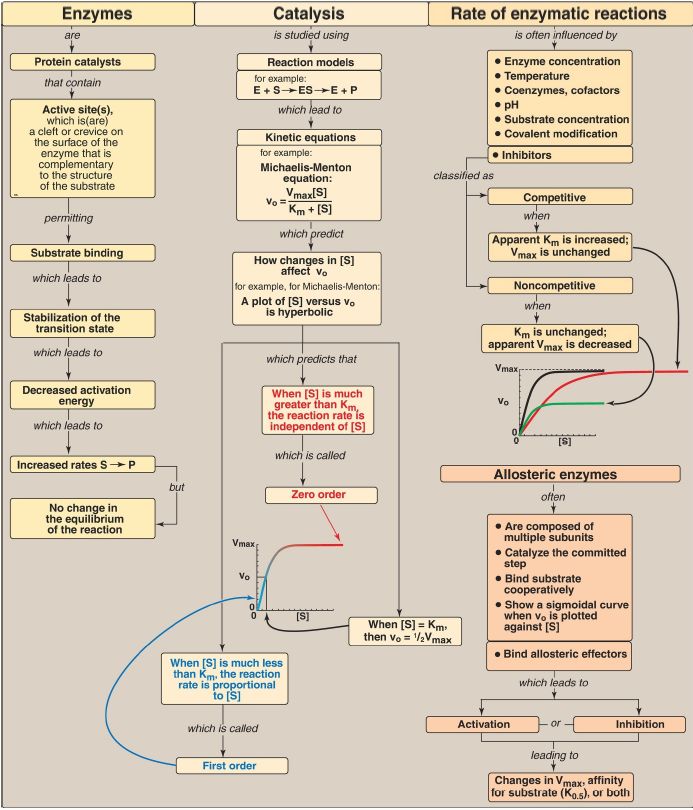
Enzymes
 المؤلف:
Denise R. Ferrier
المؤلف:
Denise R. Ferrier
 المصدر:
Lippincott Illustrated Reviews: Biochemistry
المصدر:
Lippincott Illustrated Reviews: Biochemistry
 الجزء والصفحة:
الجزء والصفحة:
 9-9-2021
9-9-2021
 1537
1537
Enzymes
Enzymes are protein catalysts that increase the velocity of a chemical reaction by lowering the energy of the transition state (Fig. 1). They are not consumed during the reaction. Enzyme molecules contain a special cleft called the active site, which contains amino acid side chains that participate in substrate binding and catalysis. The active site binds the substrate, forming an enzyme–substrate (ES) complex. Binding is thought to cause a conformational change in the enzyme (induced fit) that allows catalysis. ES is converted to enzyme and product. An enzyme allows a reaction to proceed rapidly under conditions prevailing in the cell by providing an alternate reaction pathway with a lower activation energy (Ea). Because the enzyme does not change the free energies of the reactants or products, it does not change the equilibrium of the reaction. Most enzymes show Michaelis-Menten kinetics, and a plot of the initial reaction velocity (vo) against substrate concentration ([S]) has a hyperbolic shape similar to the oxygen-dissociation curve of myoglobin.
A Lineweaver-Burk plot of 1/v and 1/[S] allows determination of Vmax (maximal velocity) and Km (Michaelis constant, which reflects affinity for substrate). Any substance that can decrease the velocity of an enzyme-catalyzed reaction is called an inhibitor. The two most common types of reversible inhibition are competitive (which increases the apparent Km) and noncompetitive (which decreases the apparent Vmax). In contrast, the multisubunit allosteric enzymes show a sigmoidal curve similar in shape to the oxygendissociation curve of hemoglobin. They typically catalyze the committed step of a pathway. Allosteric enzymes are regulated by molecules called effectors that bind noncovalently at a site other than the active site.
Effectors can be either positive (increase enzyme activity) or negative (decrease enzyme activity). An allosteric effector can alter the affinity of the enzyme for its substrate (K0.5), the maximal catalytic activity of the enzyme (Vmax), or both. Enzymes can also be regulated by covalent modification and by changes in the rate of synthesis or degradation. Enzymes have diagnostic and therapeutic value in medicine.

Figure 1: Key concept map for the enzymes. S = substrate; [S] = substrate concentration; P = product; E = enzyme; vo = initial velocity; Vmax = maximal velocity; Km = Michaelis constant; K0.5 = substrate concentration that gives half maximal velocity.
 الاكثر قراءة في الكيمياء الحيوية
الاكثر قراءة في الكيمياء الحيوية
 اخر الاخبار
اخر الاخبار
اخبار العتبة العباسية المقدسة


